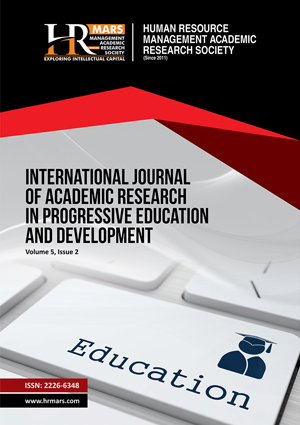
ISSN: 2226-6348
Open access
VARK Model Analysis delves into the diverse landscape of learning preferences exhibited by students enrolled in Construction Technology courses. Recognizing the crucial role of aligning instructional methods with individual learning styles, this study aims to identify the dominant learning modalities within this academic context. It highlights the multifaceted nature of the Construction Technology field and the potential challenges associated with catering to a heterogeneous student population. It underscores the importance of this research in bridging the gap between pedagogical strategies and student needs. Issues arising from the varied learning styles present within the student cohort are acknowledged, emphasizing the potential impact of instructional misalignment on knowledge acquisition and skill development. This study seeks to address these issues systematically. The main objective of this study is to identify the dominant learning styles through rigorous quantitative analysis, employing SPSS as the primary tool. The questionnaire based on the VARK model is administered to selected Construction Technology students to discern their preferred modalities of learning. Findings reveal the prevalence of specific learning styles within the academic context. These results hold significant implications for both lecturers and students. In conclusion, this research contributes valuable insights into the learning landscape of Construction Technology education. By identifying dominant learning styles, it provides a foundation for more effective and inclusive instructional practices. This study underscores the importance of adapting pedagogy to accommodate diverse learning preferences, ultimately enriching the educational experience for both educators and students in Construction Technology courses.
Abante, M. E. R, Almendral, B. C., Manansala, J., E and Manibo, J (2014). Learning Styles and Factor Affecting the learning of general engineering students, International Journal of Academic Research in Progressive Education & Development, Volume 3, No 1.
Abutaher, M.I.S (2017). Learning Styles Preferences among Quantity Surveying Students.
Belt, E.S., & Lowenthal, P.R., (2022) Synchronous video-based communication and online learning: an exploration of instructors perceptions and experiences, Education and Information Technologies, 28, 4941-4964
Bunce, D.M. (2010). Prior knowledge activation: Inducing engagement with complex systems through the construction of interactive concept maps. Instructional Science, 38(5), 523-560
Chudley, R., & Greeno, R (2010). Building Construction Handbook (8th Ed.) Routledge
Cirulli, F., Elia, G., Lorenzo, G., Margherita, A., & Solazzo, G. (2016). The use of MOOCs to support personalized learning: An application in the technology entrepreneurship field.
Coffield, F., Mosely, D., Hall, E., & Ecclestone, K. (2004). Learning styles and pedagogy in post -16 learning: A systematic and critical review. London: Learning and Skills Research Centre.
Cuthbert, P.F (2005). The student learning process: Learning styles or learning approaches. Teaching in higher education, 10(2), 235-249.
Felfer, R.M., & Solomon, B.A. (1997). Index of learning styles. Retrieved from https://www.ncsu.edu./felder-public/ILSpage.html
Fleming, N.D. (2011). Teaching and learning styles: VARK strategies. Christchurch, New Zealand.
Gappi, L.L (2013). Relationship between learning styles preferences and academic performance of students. International Journal of Educational Research and Technology, 4(2), 70-76.
Hammond, L.D., Flook, L., Channa, C., Barron. B., Osher,D., (2019). Implications for the educational practice of science of learning and development., Applied Developmental Science, Volume 24, Issue 2
Hwang, S.L., Wang, C.Y., Chen, S.Y., Chang, C.H. & Lin, T.C. (2017). The development of an augmented reality-based ubiquitous learning system for science education. Journal of Educational Technology & Society, 20(1),32-44
Ibrahim, N. & Zulkipli, Z.A (2022). The Diversity of Learning Styles and Academic Performance of Biology Students, , International Journal of Academic Research in Progressive Education & Development, Volume 11 (4), 450-464
Kokoc, M. (2019). Flexibility in e-Learning: Modelling its Relation to Behavioural Engagement and Academic Performance, Themes in eLearning, Volume 12, 1-16
Means, B., Toyama, Y., Murphy, R., Bakia, M., & Jones, K. (2013). Evaluation of Evidence-Based Practices in Online Learning: A Meta-Analysis and Review of Online Learning Studies. U.S. Department of Education.
Panjaitan, S M., Hutauruk, A J B., Sitepu, C., Gultom, S P., Sitorus, P., Marbun, M R., & Sinaga, C H. (2023). Implementation of Online Learning and its Impact on Learning Achievement of Mathematics Education Students.
Pashler, H., McDaniel, M., Rohrer, D., & Bjork, R. (2009). Learning Styles: Concepts and Evidence, Psychological Science in the Public Interest, Volume 9, Issue 3, SAGE Journal.
Payarom, S., & Payaprom, Y., (2020). Identifying learning styles of language learners: A useful step in moving towards the learner-centered approach, Journal of Language and Linguistic Studies, 16(1), 59-72
Rhode, J. (2009). Interaction Equivalency in Self-Paced Online Learning Environment: An Exploration of Learner Preferences, The International Review of Research in Open and Distributed Learning (Unpublished Doctoral Thesis, Capella University).
Russo, D., Albert, C., & Orozco, L. (2019). Learning construction technology through the virtual construction site: A case study of design-build education in architecture. Journal of Construction Engineering and Management, 145(5).
(Noor & Ramly, 2023)
Noor, S. N. A. M., & Ramly, M. K. A. (2023). Bridging Learning Styles and Student Preferences in Construction Technology Education: VARK Model Analysis. International Journal of Academic Research in Progressive Education and Development, 12(3), 2075-2085.
Copyright: © 2023 The Author(s)
Published by HRMARS (www.hrmars.com)
This article is published under the Creative Commons Attribution (CC BY 4.0) license. Anyone may reproduce, distribute, translate and create derivative works of this article (for both commercial and non-commercial purposes), subject to full attribution to the original publication and authors. The full terms of this license may be seen at: http://creativecommons.org/licences/by/4.0/legalcode